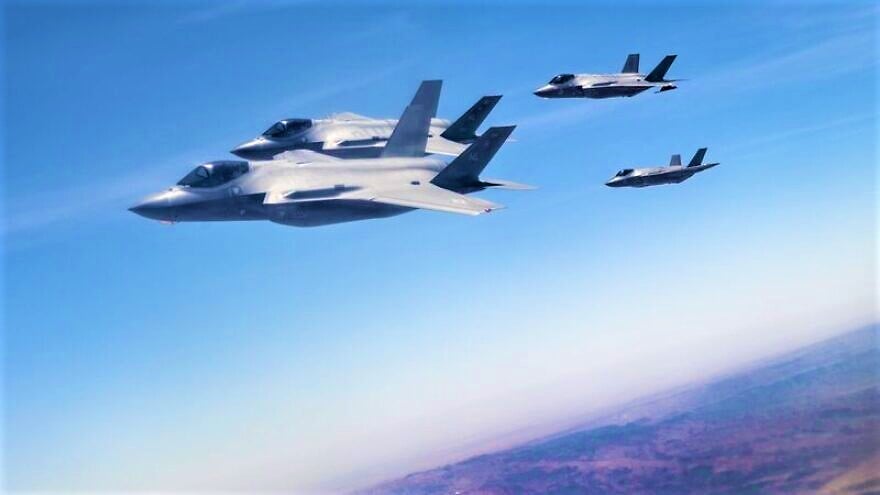The team simulated air-to-air missions against both hostile planes and ground threats, including an array of enemy missile batteries.
By Yaakov Lappin,JNS
A joint drill held by the Israeli and American air forces, held earlier this month, saw new levels of learning and cooperation between F-35 jet pilots from both nations, a senior IDF official told JNS.
The “Enduring Lightening 2” exercise, held over southern Israel, took place just four months after the first “Enduring Lightening” exercise in line with hopes by planners that the drill becomes a set feature in the development of both air forces.
Jets from the U.S. Air Forces Central Command’s 421 Squadron, which operate F-35s, flew together with the Israeli Air Force’s (IAF) 140th F-35 Squadron.
They were joined by the IAF’s 122nd Squadron, which operates the Nachshon airborne early-warning and control planes, and American JC-10 refueling aircraft. Israeli F-15s flew as part of the “Red Team,” which simulates enemy aircraft.
“The forces worked together as a team with joint communications in order to locate and neutralize each threat,” the IAF said in a statement.
“This was a step forward from the past exercise,” the official told JNS. “It simulated more complex threats, and featured real teamwork and cooperation in the same formation.”
“We conducted mid-air refueling with an American refueler,” he added.
Joint Data Network in the Sky
One of the major advantages of the F-35 is its ability to transfer data over an array of channels.
“We took a step forward by connecting all of the communication channels between the Israeli and American F-35s,” explained the source. “This is the first time we managed to do this. Hopefully, next time, it will be easier to do now that we’ve succeeded. This makes exercises much more intimate. We transferred classified data in the midst of the exercise.”
Creating a joint data network in the sky is a significant breakthrough, said the source.
The joint team simulated air-to-air missions against hostile planes and against ground threats, including an array of enemy missile batteries. “They had to attack and destroy targets, and bring down enemy aircraft,” the source stated.
The fact that Israel handled the airborne control aspect of the exercise while the United States was in charge of refueling all of the F-35s meant that “all of the layers of operations were divided half and half” between the two air forces, he said.
The exercise lasted a single day, though future drills may last longer. The length partly depends on where the U.S. jets are deployed in the region at any given time, as well as restrictions in place at any given time due to the coronavirus pandemic.
According to the IAF, the exercise was held within the coronavirus guidelines of Israel’s Ministry of Health, with planning and debriefing done at a distance and through digital means.
‘Strengthening Future Military Cooperation’
The official explained that this kind of drill enables the two countries that are the first to operate the F-35 in real combat conditions to share lessons together. “Aside from ourselves, the Americans are the best learning source for operating the aircraft, and the same is true for them regarding us,” said the source. “So the joint experience of the first countries to operate this plane creates a significant contribution. This is important.”
Each such exercise builds confidence and familiarity between the aircrews, and that level of trust enables more complex drills to follow. “When we meet for future drills, either bilateral or in a third country, we will already be highly familiar with one another,” said the official.
Another difference between this exercise and others involving older, fourth-generation planes, is that the aircrews are operating the same planes and on-board systems, the IDF source said. “Here they are flying the same plane, the same systems, and the same capabilities, conducting the same mission at the same time. The level of learning and orientation is at a different level. We’re not looking at other systems and other capabilities—we’re looking at capabilities that are exactly what we have, and we can ask, are they flying the aircraft like us? If not, now can that be if we think we are the best operators,” said the official.
Such questions open the door to valuable lessons and improvements for both sides.
“We hope that the next drill happens as soon as possible,” he said.
In a statement, the IAF said that the two air forces maintain close cooperation, including mutual learning and the sharing of lessons.
This exercise illustrates the close relationship between the air forces and military echelons, and enhances the cooperation of knowledge and capabilities of the F-35 and the IAF’s operational abilities.”
It added that “even during times of national crisis, the IAF conducts and will continue to conduct international exercises that are significant to strengthening future military cooperation and defending Israel’s skies.”
HELP ISRAELIS BATTLE CORONA!
Donate to the Corona Emergency Relief Fund. Coronavirus has taken a huge toll on the people of Israel. The poor, elderly and ill are most vulnerable.
Israeli soldiers, security officers and medical care providers operate under great danger and risk to life.
Over 1 million Israelis are out of work. Many cannot make ends meet. We provide financial aid, food, medical supplies and more. Funds are distributed where needed most. The time to act is now!
United with Israel extends a special note of appreciation to the Genesis Prize for their generous support.
Do You Love Israel? Make a Donation - Show Your Support!
Donate to vital charities that help protect Israeli citizens and inspire millions around the world to support Israel too!
Now more than ever, Israel needs your help to fight and win the war -- including on the battlefield of public opinion.
Antisemitism, anti-Israel bias and boycotts are out of control. Israel's enemies are inciting terror and violence against innocent Israelis and Jews around the world. Help us fight back!
